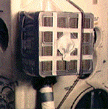You don’t have to be a Star Trek fan to be familiar with the phrase “Beam me up Scotty.” The creators of Star Trek imagined many far-out future technologies. The transporter is probably one of the most recognizable and famous. Ironically, the transporter wasn’t originally supposed to be used.
According to the 2005 documentary, “How William Shatner Change the World” (business is slow in January, I’ve got a lot of time on my hands), the crew of the Enterprise was supposed to land on the target planet. However, landing scenes required additional sets and props. When it came time to film the first landing sequence, the design shop didn’t have those sets and props ready. The writers had to come up with a different plan. They needed to come up with something that they could do quickly and cheaply. That “plan B”, the transporter, went on to become one of the signature features of the series.
This reminded me of one of my favorite innovation scenes in a movie. This one is also based on space exploration (although this wasn’t science fiction, it was real): Apollo 13.
Due to an accident after takeoff, the crew members had to fly the ship from the lunar module rather than the command module.
The lunar module’s filters were designed to accommodate two crew members for one and half to two days. Since the module now had to support three crew members for four days, the filters were running out of capacity. The carbon dioxide levels were beginning to reach toxic levels.
Ironically, there were plenty of filters in the command module. However, the command module’s filters were square while the lunar module’s filters were round. The ground team had to figure out how to connect the two using only materials that were available on board (e.g., plastic bags, cardboard, and duct tape).
The ground team ultimately met the challenge of “putting a square peg into a round hole” and saved the astronauts.
 |
| Putting a square peg into a round hole (http://er.jsc.nasa.gov/seh/apollo13.html) |
Both of these are excellent examples of innovation. Three things make these particular innovations stand out:
- Both happened in situations where a high degree of innovation already had occurred: the development of a science-fiction television series and the United States space program.
- The initial innovations (TV show, Space Program) took many months (or even years) of planning and used large amounts of resources, yet these two specific innovations had to occur with extreme constraints (time, resources)
- Both went on to be among the most memorable symbols of their respective events
Too often, leaders complain that they are stifled from being innovative due to constraints (lack of time, resources, people, money, etc.)
The game changers and legends in business and history are those people who find ways to overcome constraints rather than being shut down by them.
———————
Brad Kolar is the President of Kolar Associates, a leadership consulting and workforce productivity consulting firm. He can be reached at brad.kolar@kolarassociates.com.


